VOL.49, NO. 1
The Taming of the (Arab-Islamic) Shrew : Fatin ‘Abdel Wahab Re-frames Shakespeare’s Comedy for the Egyptian Screen1
Yvette K. Khoury (Blackfriars/University of Oxford, U.K.)
Literature/Film Quarterly, 2010, Vol. 38, No. 2 (2010), pp. 147-162
The Egyptian film industry has produced five features based on The Taming of the Shrew—al-Zawjat al-Sabi'a (The Seventh Wife, 1950), Banat Hawwa (Daughters of Eve, 1954), Ah Min Hawwa (Beware of Eve, 1962), al-Mutamarrida (The Unruly Female, 1963), and Istakoza (1996),2—out of which Fatin ‘Abdel Wahab’s 1962 Hawwa seems most captivating.3 As a researcher in Arabic Shakespeare my initial reaction upon seeing Ah Min Hawwa was to question why this film should have escaped critical attention. We cannot, with all honesty, claim that this black-and-white film is a great piece of art. Indeed, the cinematography and mise-en-scène are nothing to boast about: the majority of the action is taken in mid-to-wide shots, crosscuts are kept to a minimum, and the camera movement is largely static. On the surface, then, ‘Abdel Wahab’s film, which has suffered from forty odd years of neglect, seems to have little to offer. However, despite its shortcomings, the film is an important link in the history of filming the Shrew and wider Arabic Shakespeare studies. The imaginative setting, the manipulation of Shakespeare’s plot, the acting, and the use of musical score are not only superlative but they are also informative about re-framing Shakespeare into Arabic.
I intend, therefore, to relate Ah Min Hawwa to Shakespeare’s comedy and demonstrate how this Shrew validates aspects of the socio-political environment of 1960s Egypt. I will examine how Shakespeare’s plot is made to “fit” Arab-Islamic social culture and argue that ‘Abdel Wahab’s portrayal of the Shrew highlights some of the class and sexual tensions between Amira Amin (Katherine) of the Egyptian elite and Dr. Hasan Shukri (Petruchio), an upper-middle-class veterinarian specialist. I will describe sections of the film in some detail to help demonstrate how ‘Abdel Wahab establishes Amira’s unruly nature.4 I hope this close reading will capture the film’s tempo and illuminate the reader’s understanding of what makes Shakespeare’s comedy “speak” to post-revolution Egyptian audiences.5
Ah Min Hawwa is what Kenneth Rothwell categorizes as a “Shakespearean derivative” (192-218), meaning it is a metaphoric (indirectly related) Shrew. Unlike other metonymic (directly sourced) Shrew features that tend to imitate Shakespeare’s structure and language, such as Sam Taylor’s (1929) or Franco Zeffirelli’s (1967) productions, Ah Min Hawwa resembles films like McLintock (Andrew V. McLaglen, 1963), Ten Things I Hate About You (Gil Junger, 1999), Deliver us from Eva (Gary Hardwick, 2003), and the BBC’s Shrew in the Shakespeare Retold series (David Richards, 2005), all of which are inventive and modern (dress and language)6 “derivatives” of the Shrew. As a Shakespearean derivative, the plot of Ah Min Hawwa is considerably slimmer. Almost the entire subplot of Bianca’s suitors is omitted; this includes Lucentio’s disguise, Tranio’s impersonation of Lucentio and all that entails. In addition, the characters’ names are altered: some are Arabicized—Amira (Katherine), Nadya (Bianca), Lam'i (Lucentio); while others are Islamized—Hasan Shukri (Petruchio) and Sayyid Amin.7 Moreover, the sisters’ patriarchal authoritative figure is not their father (Baptista) but their grandfather Sayyid Amin, nicknamed ghiddu ‘granddaddy.’
Of all Shakespeare’s comedies, The Taming of the Shrew seems to resonate most with the domesticity of Arab-Islamic patriarchal societies.9 ‘Abdel Hakim Caracalla, who adapted three Shakespearean plays for the Middle Eastern stage, claims that “the subjugation of women to men as in The Taming of the Shrew is a phenomenon which is more oriental in spirit than western” (qtd. in Kanaan 190).10 Indeed, a sexist reading of the play would surely seem appropriate to any patriarchal society, but what makes Ah Min Hawwa unique is its 1960s Egyptian setting; a time, I suggest, when intra-Arab-Islamic social values were being redefined and when East and West material cultures were almost indistinguishable.
From its infancy, The Taming of the Shrew has triggered strong responses.11 It is perhaps not surprising, therefore, that the Shrew was the first of Shakespeare’s plays to be rewritten for the Restoration theatres.12 To be sure, Sam Taylor’s 1929 feature was the first Shakespeare “talkie” (Rutter 141). However, the Shrew’s concern with morality makes it, as Ann Thompson determines, a problem play for the majority of today’s western societies (41). Critics have called it “disgusting” and “barbaric.”13 Michael Billington questions “whether there is any reason to revive a play that seems totally offensive to our age and our society” (qtd. in Thompson 17).14 By contrast ‘Abdel Wahab’s film seems to reinforce the play’s vision of male supremacy, patriarchal and misogynistic accretion, and implies its acceptability in Arab-Islamic societies. We therefore need to ask what makes Shakespeare’s comedy “fit” the twentieth-century Arab-Islamic framework.
It is reasonable to claim that Arab-Islamic societies promote ideas about women similar to those in Shakespeare’s time: “women should be chaste, silent, and obedient” (Dolan 4). Indeed, some of the play’s cultural values have similarities with Arab-Islamic societies, such as the insistence on marrying the elder daughter before the younger. Significantly though, the shrew in ‘Abdel Wahab’s film, like that in Niyazi Mustafa’s, is not only one specific female (Katherine)—she is all women. Thus, an Arab-Islamic Shrew is, like the anonymous “Shrew” referred to by Thompson, written from the view that “women should submit to men because they were created by God as inferior beings and were moreover responsible for the Fall of man from Paradise” (29, my italics). This Biblical concept is not only relevant to Arab-Islamic culture, but it is also made explicit in the tide of the film where hawwa’/Eve is Woman.
What, we might ask, constitutes an unruly woman on the Egyptian screen? It would largely depend on the film’s premise, but, on the whole, she is, like Amira, dynamic, outspoken, and craves gender equality. For example, in al-Mutamarrida Sawsan/Katherine is passionate and impulsive whereas Sami/Petruchio is level-headed and pragmatic. She is a businesswoman and a society girl but he is forced to work as an illustrator in her father’s textile factory to help keep his bed-ridden mother. Both of the 1950s films fall into the farce category15 and both have the same three principal actor/singer stars: Muhammad Fawzi (who also composed the music for both films), Shadya, and Isma'il Yasine.16 In Banat Hawwa, ‘Ismat/Katherine (Madiha Yusri) is a headstrong business executive who is devoted to the empowerment of women. When ‘Ismat runs Wahid/Petruchio (Muhammad Fawzi) over in her car, the struggling artist falls in love instantly. However, ‘Ismat had vowed that she would “never fall in love.” Conversely, ‘Ismat’s younger sister Hikmet/Bianca (Shadya) is engaged to Anannas/ Lucentio (Isma'il Yasine) but cannot marry before ‘Ismat. The plot of al-Zawjat al-Sabi'a is altered slightly: Samiha’s/Katherine’s (Mary Kwayni) father has been disgraced by losing his fortune and Wahid Bey/Petruchio (Muhammad Fawzi)17 is a wealthy man who has divorced six wives because “they don’t breed.”18 Wahid falls instantaneously in love with Samiha who does not reciprocate. Su’ad/Bianca (Shadya) sets out to help Wahid woo and marry Samiha since the engaged Su’ad cannot marry before her elder sister. On their wedding night, Samiha discovers the truth about Wahid’s numerous divorces and sets out to “teach him a lesson”; she forces him to divorce her because she is unruly and not for biological reasons.
‘Abdel Wahab sets his film in contemporary 1960s Egypt, away from the metropolis on Sayyid Amin’s (Husayn Riyad) country estate where he lives with his granddaughters Amira (Lubna ‘Abdel ‘Aziz) and Nadya (Madiha Salim), who is engaged to Lam'i (‘Abdel Mun'im Ibrahim). Unlike Bianca and Lucentio, the relationship between Nadya and Lam’i is well established. For one thing, they are cousins and have been, during their three-year engagement, unsuccessfully trying to match Amira off, since it is customary for the elder sister to marry first. This notion echoes Baptista’s insistence that Katherine must wed before Bianca (I.i.48-54).19 But Amira is no fool for she tells Nadya, “Your grandfather wants to get rid of me because if you wed first, he’ll be stuck with my presence.” However, by a twist of fate/plot, Nadya weds before Amira, who ends up living in sin.
It is mainly for this reason that Amira must have a grandfather; a father figure consenting to his unmarried daughter living alone with a man would be inconceivable to Arab-Islamic audiences. Indeed, all Arabic Shrew films make this distinction: the sisters in Banat Hawwa have a matriarchal uncle and the shrew in Iztakoza has a matriarchal aunt. Even when the father is present, he is usually socially disgraced. For example, the father in al-Zawjat al-Sabi'a, who has lost his fortune and accumulated large debts, works as a gigolo in exclusive hotels. In al-Mutamarrida, Sawsan’s father is a rich businessman who, in the past, had placed his business expansion before his wife’s health and subsequently feels responsible for her death.20
The animals on Sayyid Amin’s estate have been struck down by a terrible disease during harvest, which has left his entire fortune at stake. A specialist veterinarian has been summoned from Cairo. Dr. Hasan Shukri (Rushdi Abazah) comes with the highest recommendations. The concerned owner, Sayyid Amin soon realizes that Hasan could not only cure the livestock but he could also help tame “the animals upstairs”; namely his unruly granddaughter Amira. Sayyid Amin complains, “She respects no one or any situation [...] If she had been a boy,” he declares, “I would’ve disowned her. But she is a girl—that means she is a thorn in my back.” Therefore, Amira is a burden to her grandfather as well as being a hindrance to her sister’s happiness. Encouraged by Sayyid Amin and slightly intrigued by Amira’s unpredictability when he encounters her as a stranger on his way to the estate, Hasan takes up the challenge of taming the shrew.
Conversely, Amira finds Hasan utterly despicable and totally detestable. She goes to great extremes to get him dismissed; however, all events seem to conspire against the highly spirited Amira until she is forced to marry the “bull-minded”21 Hasan. Muhammad Abu Yusuf ingeniously rewrites Shakespeare’s animal metaphors22 to make them “fit” the plot of Ah Min Hawwa where the tamer, Hasan, is a veterinarian doctor who cures the unruly “ass” (Amira). Moreover, the doctor-patient relationship gives the couple certain physical freedom that would otherwise be unacceptable in an Arab-Islamic social order. For instance, Hasan sits on Amira’s bed and exposes her thigh to implement the injection.
The shrew in Ah Min Hawwa is a sophisticated and complex character. On the one hand, she perceives all men as stupid creatures and displays cruelty toward man and mammal but, on the other hand, Amira can be charming and carries a magnetic supremacy about her that gives her the confidence to stand up for herself. This high self-regard gives her a regal status signified by the car she drives (Cadillac), the tiara she wears, and especially her name, Amira—the literal translation of which is “princess.”
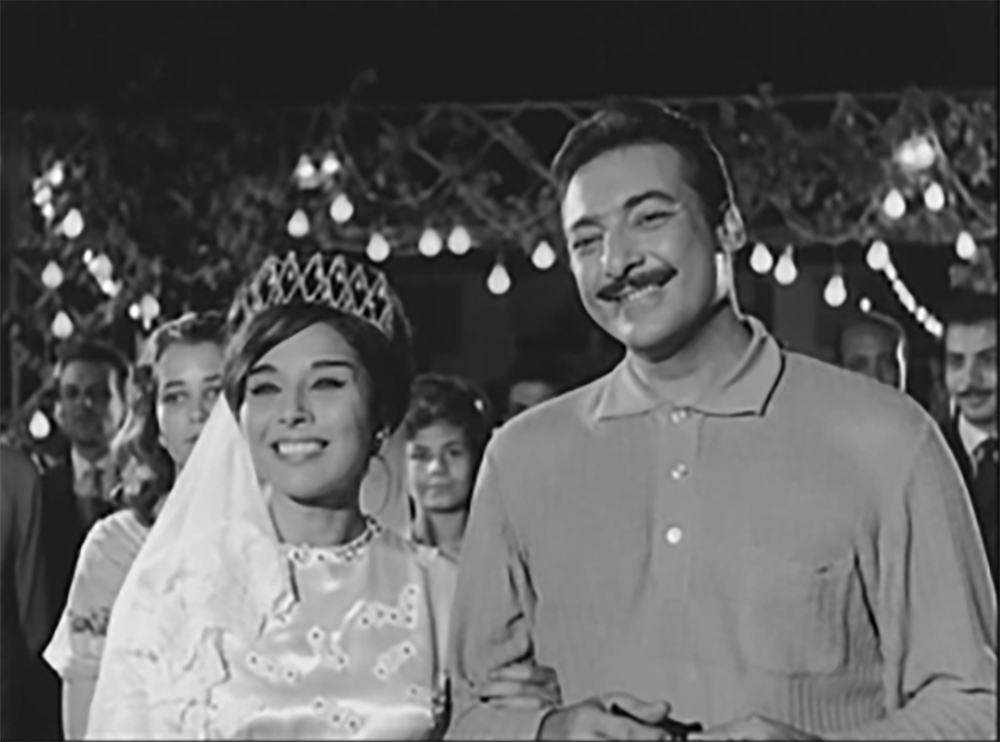
However, for every assertive tone, every outspoken word she utters, Amira faces an equal moment of ridicule. For example, Hasan gives two main reasons for refusing to marry Amira: he would not marry a “woman with a wagging tongue,” or one with a shanab ‘moustache.’ Amira does wear some sort of “moustache” in the first few moments of the film, which is meant to humiliate her and ridicule her looks. The metaphor of the moustache, which symbolizes unruly nature, is also used in Banat Hawwa. Wahid declares:
Man is man even if he has a tail, and woman is woman even if she has facial hair.
The contrasting personalities of Amira and Hasan unfold during the credits’ sequence of ‘Abdel Wahab’s film; she races her shiny 1957 Cadillac convertible23 (Eldorado Brougham) whereas he cruises leisurely in his battered Citroen CV2. When Amira’s car comes to an abrupt halt, a close-up reveals a bull snorting at her. The free-spirited, fast-driving “princess” has been stopped in her tracks by a bullish male symbol that refuses to bow to her air of superiority; this is Amira’s first confrontation with the “bull-minded” Hasan.
Unable to restart her car, Amira tries to investigate under the hood. Hasan stops his Citroen in the same shot, opens the car door, and asks, “Can I be of any assistance Pasha?”24 Amira swivels sharply and says facing him, “What do you mean Pasha, comrade”25 She simultaneously places the first finger of her right hand across her face, “Do I look like I’m wearing a moustache?”; her action leaves a black grease mark across her face, thus forming an artificial moustache.
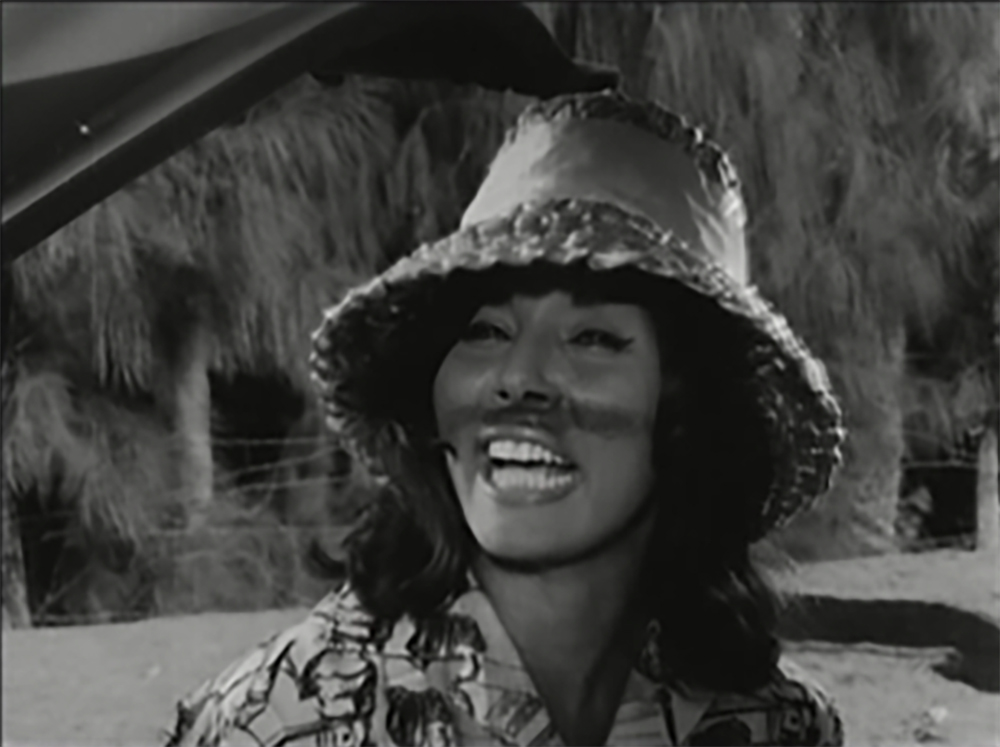
Hasan suavely removes his pipe and calmly replies, “Sorry madam, but only your trousers were visible.” “How clever you are,” she replies sharply, “are men the only ones who wear trousers?” before turning back to attend to the engine. The camera crosscuts to Hasan who has an amused look on his face; Hasan’s visible smirk leaves us wondering if he intentionally called her “Pasha” since her straw hat, her shapely figure, and her stilettos are clearly visible to him. Nevertheless, the opening few minutes of ‘Abdel Wahab’s film show Amira’s aggressiveness toward the driver of the battered CV2. However, as the film unfolds, we soon realize that Amira is also rude to her menservants; she calls them by an array of abusive titles: “animal,” “idiot,” “moron,” and “stupid.” Hasan overhears her insult an old man and asks, “Who might she be?” “This is Amira, my granddaughter,” replies Sayyid Amin. Hasan thus realizes that the woman with the broken-down Cadillac is none other than his new boss’s granddaughter.
The next stage of Amira’s rowdiness verges on disrespect toward her elders. When Amira eventually arrives home riding on a hay cart (moustache intact),26 Nadya gasps upon seeing her sister’s face and asks, “What’s that moustache doing on your face?” “Moustache?!” Amira screams and walks toward the mirror. Not knowing that Hasan can overhear her from Sayyid Amin’s office, Amira snatches her hat off and says, “The scum [...] lowlife!” Nadya looks astonished and tries very hard not to laugh at the comical sight before enquiring, “Who? Who is it you’re talking about? Tell me what happened.” Furious, Amira grabs a tissue and continues as she wipes the grease off her face, “The car broke down, that’s what happened. I looked up and saw the coldest man imaginable [...] rude man without any manners [...] colder than a block of ice.” Hasan’s cool and confident persona infuriates Amira because he does not fit any of the categories of men in her life: servants or patriarchal authority. In the next room, Hasan enquires, “Is she always this abusive?” “With or without a cause, my boy,” replies her grandfather.
Leaving Hasan behind, Sayyid Amin joins the sisters in the parlor and tries to calm Amira down, but she tells him to keep quiet before continuing, “If I ever see this man again, I’ll show him, I’ll not make him ride on a bundle of hay, I’ll place him in a manure cart. I’ll wipe the floor with him.” At this moment Hasan walks in. Amira stops in her tracks and watches silently while Hasan takes his leave of Sayyid Amin and thanks Nadya for the coffee before turning to exit. Amira, infuriated that Hasan should ignore her presence, turns to him and says, “Hey you!” “Yes madam,” he replies as he stops. “Are you just calmly going to walk out of here while I’m insulting you?” she asks. He replies, “Was your ladyship insulting me?!” “Yes you [...] can you be this insensitive?” she asks. “Shouldn’t we introduce ourselves first, then we could abuse one another?” he replies. “What do you mean [...] rude man. If you had any feelings at all, you would’ve said something,” she continues. “I am not ill-mannered,” he protests. “You’re right afendi,”27 she calmly replies, “you’re not ill-mannered”; she then ripostes with a change of tone, “you lack all manners.” Her grandfather tries to stop her but Amira persists, “If it wasn’t for your presence [ghiddu], I would have socked him one.” Surprised, Hasan replies, “You want to punch me?!” A profile shot reveals his stature towering over hers. “You deserve more,” she snaps confidently. Her grandfather tries to intervene but Hasan cuts in, “Let her, Sayyid Amin: she’s having a tantrum, leave her to let off some steam.” Hasan’s use of “tantrum” is as condescending as it is degrading. Socially, Amira’s behavior toward Hasan is unacceptable. As her grandfather tries to remind her, it is disgraceful to abuse his guest and it is deplorable that she should be outspoken in her elders’ presence. In Hasan’s presence, Amira feels her regal status slipping; she fights against his self-confidence with which he pulls her down to his middle-class level. This exchange highlights Amira’s characteristics as an attention seeker, disrespectful to her elders and unable to control her emotions. Hasan, by contrast, is calm, charming, and polite.
Instead of behaving like Petruchio who promises Katherine, “I swear I’ll cuff you if you strike” (Il.i.216), Hasan gets closer to Amira and says challengingly, “Here, take your shot,” pointing to his right cheek. However, Amira, realizing that attacking Hasan would confirm that she is hysterical, does not hit him, rather she stares at him blankly. “What’s the matter, why won’t you strike?” Hasan asks. “I won’t soil my hands,” she snaps. “I’ll wash your face for you,” he offers calmly. At which point Amira loses control once more and screams, “Uhhh,” before walking away in a tantrum.
When Sayyid Amin tries to apologize—“Please forgive me doctor”—Amira turns around and asks, “Doctor?! [...] You [...] a doctor?!” Sayyid Amin explains, “He is the veterinarian who has come to treat the animals.” “Ah!” says Amira before she continues dismissively, “A vet [...] he dwells with animals.” To which Hasan replies, “True I’ve lived among many animals, but I’ve never come across a female beast that has been rude towards me.” Sayyid Amin chuckles. Amira then asks, “Are you laughing, ghiddu?” “No [...] not at all my dear; only this guy has a sense of humor,” Sayyid Amin replies. “Ghiddu, kick this guy out of here,” she orders. This incident not only establishes a bond between the two men but it also isolates and humiliates Amira.
Hasan tries to escape Amira’s “madness” but gets drawn back in by her grandfather. Hasan says, “Miss Amira, I apologize if I have offended you. I am willing to [leave].” But Amira cuts in by saying, “Listen, afendi. Your mannerisms [...] your way of speaking makes me furious. Your blood is colder than normal.” To which Hasan replies, “Sure madam. But your blood is hotter than necessary.” “OUT,” she shouts, “Get OUT.” At which point Sayyid Amin asserts his patriarchal authority and insists that Hasan must remain to treat the animals. “Fine,” Amira snatches, “I’ll leave then,” and begins to ascend the stairs, but circumstances dictate that she too is trapped. “Go where, my dear?” enquires her grandfather. “What about the people that are coming to see you today?” She frowns, “People! What people?” “The suitor who wants to make you a marriage proposal,” her grandfather reminds her. However, Amira has already decided to “refuse him without seeing him.”28 These first few minutes build up a momentum that shows Amira and Hasan as two opposing forces heading toward an inevitable collision in a shifting socio-political order in 1960s Egypt.
Being sharp-tongued, rude to all men (except ghiddu), and bad tempered might have been enough “flaws” to portray Amira as a shrew. In this respect, Amira is similar to Kate who “is the archetypal scold whose crime against society is her refusal to accept the so-called natural order of patriarchal hierarchy” (Boose 192). However, there is one aspect of Amira’s character that touches Hasan personally—her attitude toward animals, which was highlighted at their first encounter. Amira reluctantly accepts a ride in Hasan’s CV2, or what she calls a “cooking-pot,” but soon Hasan stops his car. “What is the matter? Why have you stopped?” Amira asks angrily. Hasan points toward the hood of the car without looking at her. Amira moves forward in her seat (moustache intact) to observe the cause of their unscheduled stop. She spots a stationary goose on the small bridge, which is barely wide enough for the car. “Shush!” she utters angrily then orders Hasan, “Go on afendi, shush this animal out of the way,” to which Hasan replies, “She’s laying her egg.” But when Amira persists, Hasan turns to face her and says, “I’m telling you she is laying her egg,” and adds firmly, “it’s the same as a woman giving birth. Would you like me to shush you while you’re about to give birth?” Hasan’s words echo the exchange between Shakespeare’s couple; Katherine says, “Asses are made to bear, and so are you,” to which Petruchio replies, “Women are made to bear, and so are you” (Il.i.199-200, my italics). Therefore, Hasan’s statement is meant as a derogatory term, a reminder of the inevitability of her sex bearing the weight of men, bearing children and, in Hasan’s world, bearing physical domestic labor.
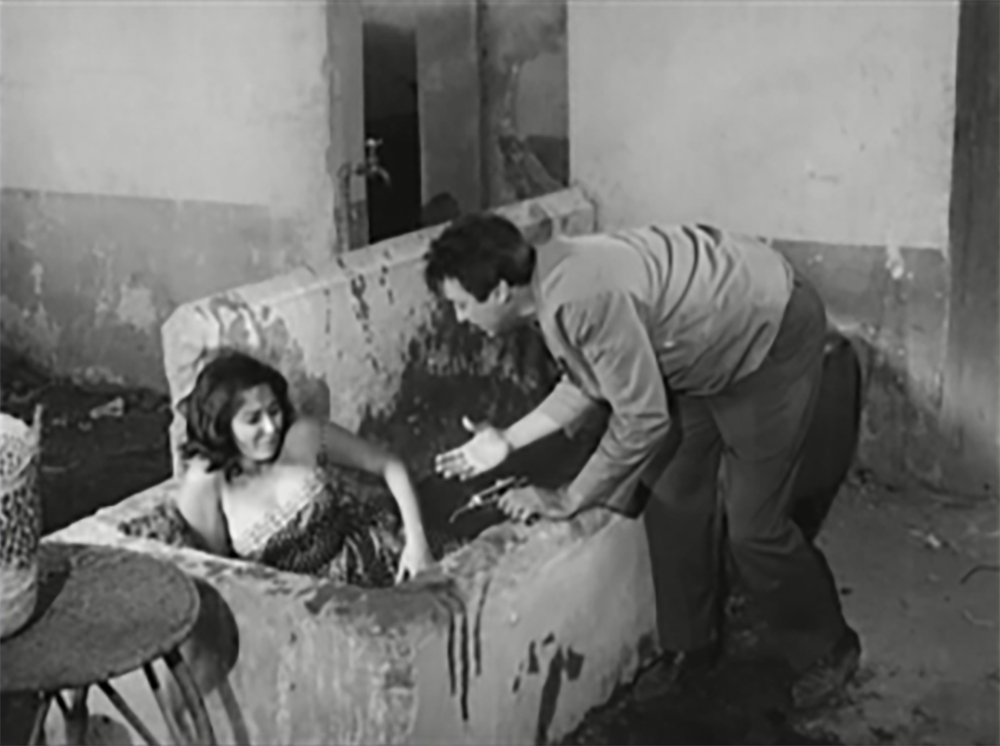
Hasan’s first day on the job highlights yet another clash with Amira over her harsh treatment of animals and establishes her as the “ass [...] made to bear.” Hasan spots an ass pulling Amira’s Cadillac and orders its release.29 He then treats the animal and prescribes two days’ rest. However, Amira ignores Hasan’s orders and tells her manservant (Mitwalli) to re-harness the ass. At which point Hasan swears that he “will beat [her] up” if she makes the animal work without its prescribed rest. Intimidated by his assertiveness, Amira falls backward into the trough containing chemically treated water for the animals (see Figure 3). Thus Amira contracts the same “ass” disease and gets treated by the same “ass doctor” who, to ghiddu’s delight (see Figure 4), uses the same animal implements and injections to cure her.
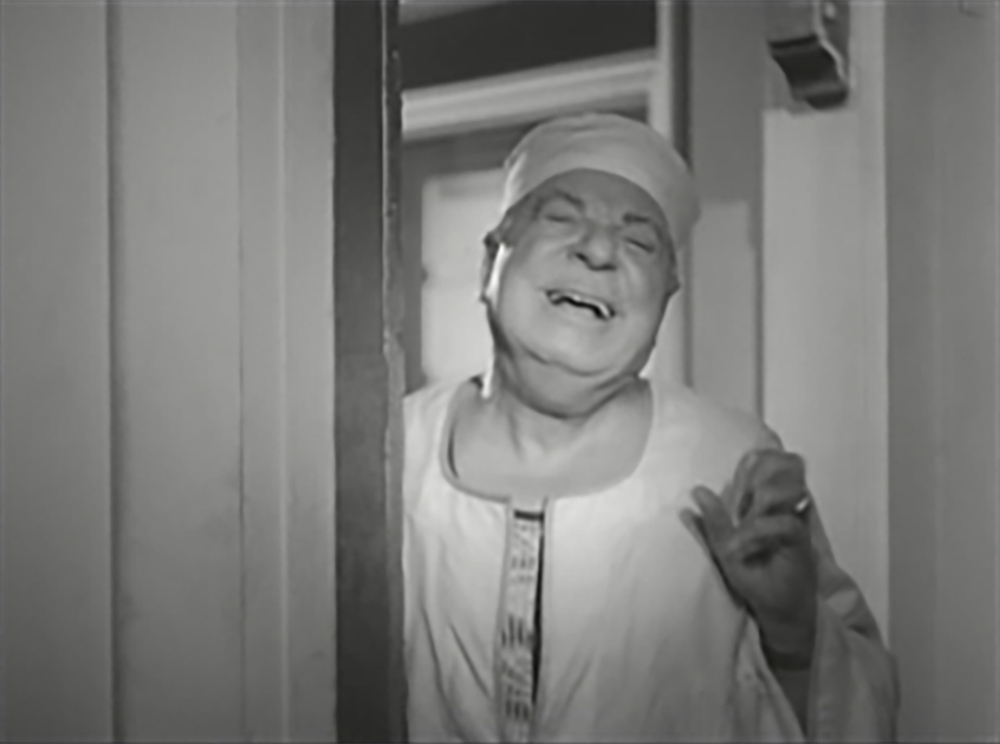
Furthermore, Hasan uses the language he does on animals. For example, when Amira refuses to be still for the injection, Hasan orders his assistant to “Hold her tail.” Once the injection is administered, Hasan tells Amira, “You’ll [soon] be kicking and galloping.” Amira, thereby, becomes the personification of al-humar ‘ass,’ which is a euphemism for an idiot.30 Moreover, the bridle Hasan tries to use on Amira (see Figure 5) resembles some of the scolds’ bridles used to control unruly women in England (Boose 208-10).31 These private incidents, however, soon become public humiliations. For example, Amira overhears one woman say to another, “Why is [Amira] not barking and kicking?” Her friend answers, “They say the vet gave her an injection.” “Ah [...] you don’t say!” the first lady replies. Amira therefore is treated like an animal, which not only humiliates her but also affirms her reputation as a shrew.
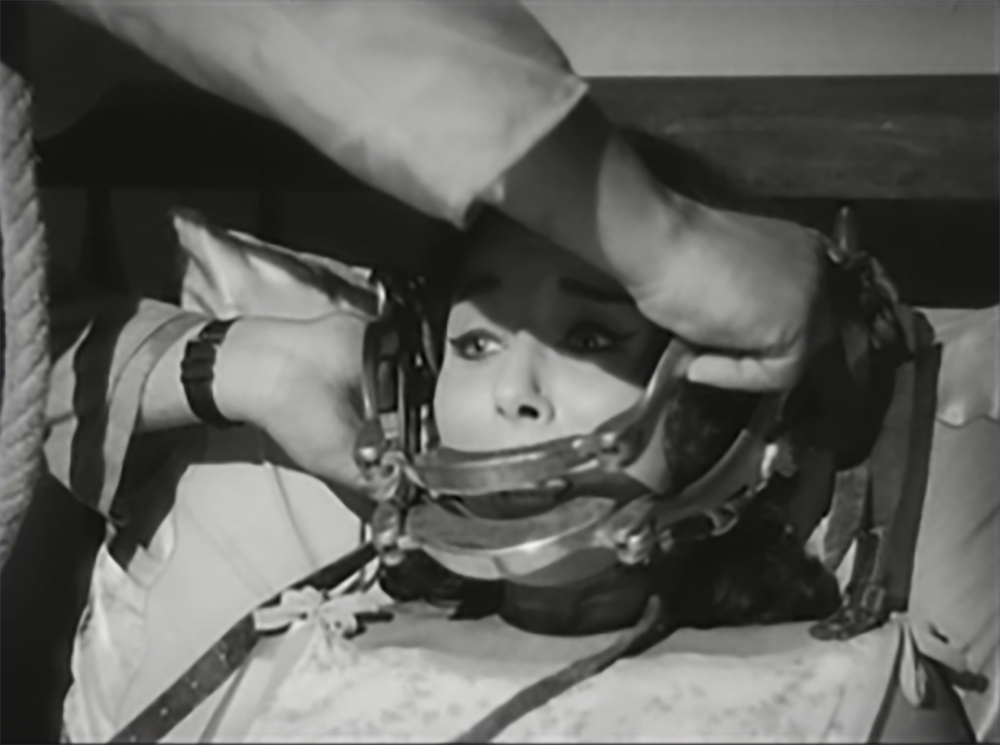
Amira recovers from the “ass” sickness and is well again in time for her birthday celebration. Infuriated by the way Hasan treated her, she vows to get rid of him once and for all; Hasan inviting himself to her party stiffens her resolve further. But instead of attending, Hasan sends Amira a statue of a four-legged creature to remind her of the ass-doctor paradigm. While Amira’s friends think the gesture cute, she finds it decidedly rude and heads to the guesthouse for a confrontation with Hasan. Once alone with Hasan, Amira becomes extremely charming and seductive. Hasan is clearly moved, for he tries to kiss her but Amira refuses by saying “No one ever kisses me.” However, on her way back, Amira tears off her dress before re-joining the party (see Figure 6). Once inside, she screams “disaster” and declares chat Hasan has attacked her and torn off her dress when she refused his advances. Unknown to Amira, however, ghiddu witnesses her exhibition and privately warns Hasan of her intentions. Consequently, instead of publicly denying Amira’s accusations, Hasan declares that he was unable to resist her charming advances; he pleads, “Either kill me or wed me.” Amira protests to no avail, for ghiddu gives his consent and announces the wedding date; the two men wink at one another, leaving Amira to sulk.
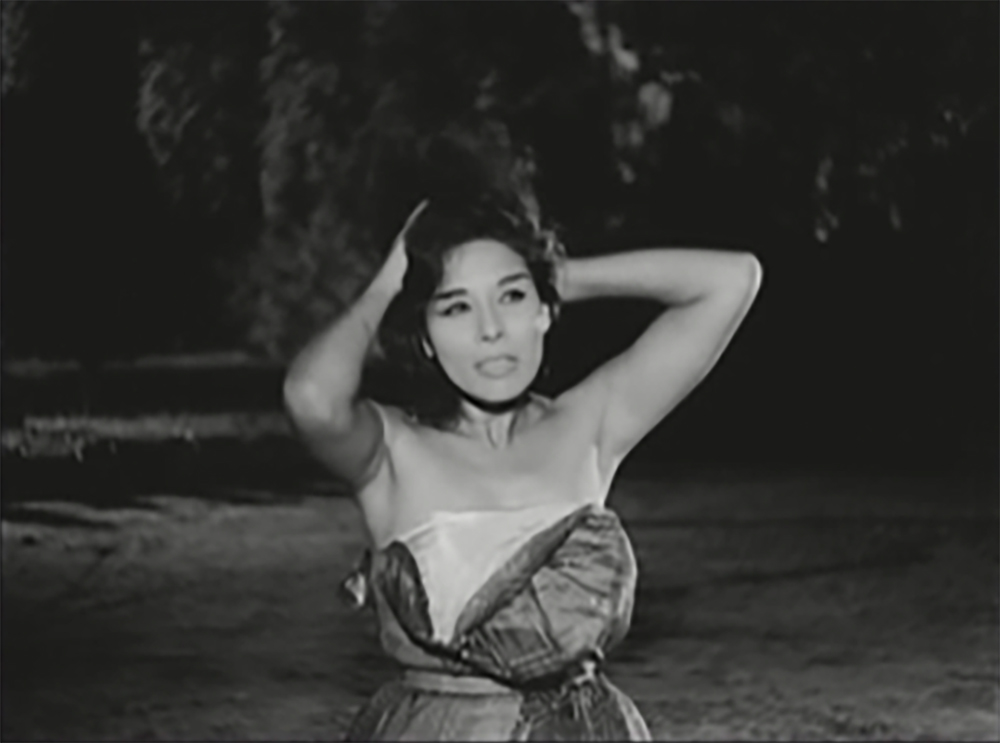
Since Hasan, like Petruchio, fails to make an appearance for the wedding, Amira is once more made to “eat her words”; having promised to “smash his wedding plans,” she is forced to pursue him. However, Hasan refuses to consent to a real marriage. He takes Sayyid Amin into his confidence—“it’s all a lie,” he explains, “she came to [my home in Cairo] and begged me to marry her to save her honor but when I refused absolutely, she came up with this suggestion: make out that we’ve wedded [...] so now it’s up to you, if you wish I can continue pretending until we tame her completely.”32 Sayyid Amin agrees to the charade (see Figure 1), which results in Amira and Hasan living in sin; thus the stage is set for taming Amira, “the ass [that is] made to bear.”
Having persuaded Hasan to lie about their marriage, Amira naively thought that she would not have to live with him, but since Hasan has ghiddu’s consent he manages to take her to the guesthouse. After the parade headed by the belly dancer (an Egyptian film tradition), Hasan picks Amira up and carries her over the threshold. Being publicly manhandled is as humiliating to Amira as Petruchio’s bawdy behavior is to Kate in Shakespeare’s original. Hasan, like Petruchio then, makes his bride “the object not of honor but of ridicule” (Boose 192). Once inside the guesthouse, Amira feels trapped and demands immediate release. “Calm down,” Hasan says, “we can put a stop to it.” “How?” asks Amira. “I’ll tell [everyone] the truth; that we’ve been paraded, the doors have been closed on us,33 without marriage certificate, and without a Ma’zun,”34 Hasan replies. However, an immediate divorce would jeopardize her female chastity; forsaking her on their wedding night, laylat al-futha,35 would signal a sullied bride. Therefore, the sham marriage not only adds to Amira’s shrew reputation, but it also jeopardizes her honor, since in Arab-Islamic societies a female’s chastity is generally valued more than her life. The Egyptian feminist, Nawal el-Saadawi, explains that families in Arab culture lament more for a girl’s loss of virginity outside wedlock than they would for the loss of her life. “A man’s honour,” Saadawi suggests, “is safe as long as the female members of his family keep their hymens intact”; if a woman loses “her life, it would be considered less of a catastrophe than if she [had] lost her hymen” (26, 31). Therefore, the minute Amira enters Hasan’s dwelling she is totally at his mercy and must play by his rules.36
Under Hasan’s roof, Amira is deprived of both food and sleep: he sleeps on the large bed while she must be content with the sofa or the floor. She must cook, clean, darn Hasan’s socks, polish his shoes, and take off his boots when he comes home from work (see Figure 7); a task she is forced to demonstrate in front of giggling family members. The taming of Amira, therefore, is not unlike that of Katherine, but it is, arguably, more degrading and has a sense of reality about it, not only because Amira’s taming is initiated by her grandfather37 but also because Hasan claims that his treatment is totally lawful; Shari'a 4:34, for example, affirms that a Muslim woman is under her husband’s tutelage, under his authority, and at his mercy. Once legally married, Hasan reminds Amira of this fact by offering her a paper note for a muhr (dowry) instead of the customary gold coin. When Amira tries to protest, he tells her, “Shut up. You’re my wife for real now.”
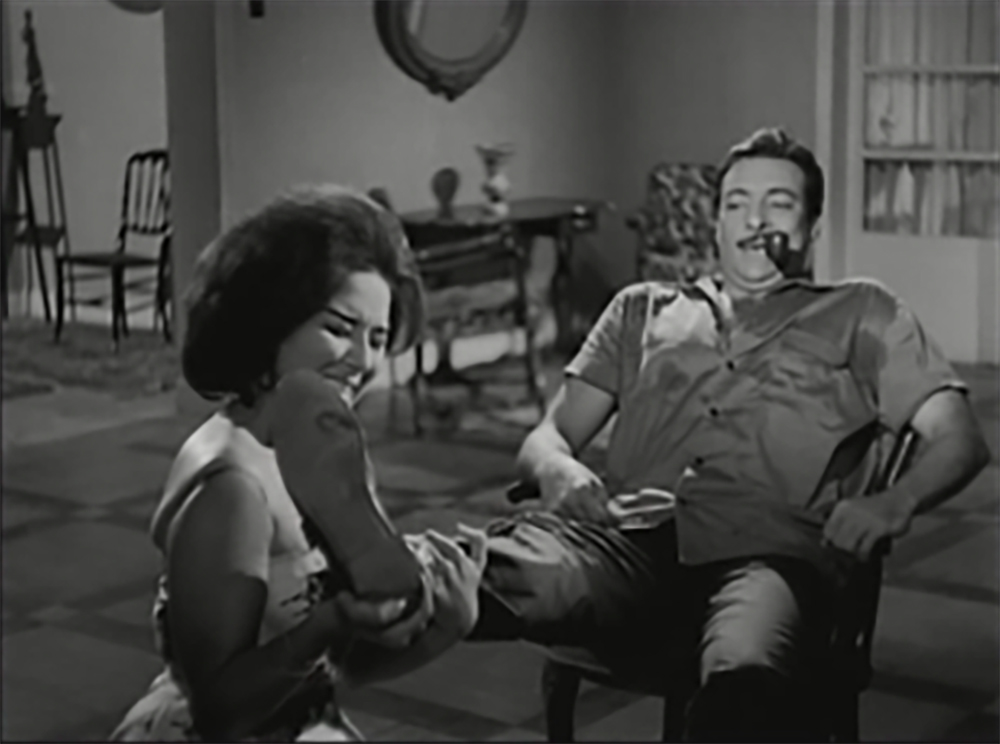
“Although Katherine is able to raise mayhem in her father’s house through words and blows,” argues Frances E. Dolan, “she is at Petruchio’s mercy […] at the marital table” (20). Similarly, the shrew in ‘Abdel Wahab’s film is forced to conform to patriarchal supremacy and carry out her wifely duties. Amira’s final public humiliation takes place over a lunch that she prepares where she intentionally places a biro in Hasan’s kufta (elongated meatballs),38 which is the “weapon” she needs to obtain a divorce and end the charade. “But,” Sayyid Amin reminds her, “in order to divorce you, he must marry you first.” At this moment Amira realizes that she had been deceived by her grandfather: she is at once the deceiver and the deceived.
‘Abdel Wahab’s international title Beware of Eve39 suggests that Eve/Woman is deceptive. The film highlights male anxieties stated in Banat Hawwa, “God protect us from the daughters of Eve, for they are deceptive.” However, surely it is Sayyid Amin who is being deceptive.40 From the start Amira’s grandfather insists that Hasan tame his granddaughter who is like “the animals that kick and thrust.” Moreover, ghiddu sanctions Hasan’s cruel treatment of Amira by consenting to his granddaughter’s fake marriage. Sayyid Amin then orders the real marriage and al-Ma’zun performs the ceremony in the guesthouse with only two witnesses, Lam’i and Zunful (Hasan’s manservant). Furthermore, together Hasan and Sayyid Amin conspire to affirm, not deny, that Muslim society in 1960s Egypt promotes patriarchal superiority; the film reinstates male supremacy and resists the gender equalities Amira tried to establish. On the one hand, Ah Min Hawwa demonstrates the visual and aesthetic similarities in Eastern and Western secular cultures, but, on the other hand, the film exposes the cultures’ contextual and linguistic differences. The material culture of ‘Abdel Wahab’s film, including the cars they drive and clothes they wear, makes Ah Min Hawwa almost Western in style but in terms of social values and language it highlights that they are worlds apart.
Ah Min Hawwa ends, as it must, with a totally tamed shrew being the contented wife of her tamer. However, Amira proves she is a fighter to the end for she shows signs of defiance during the wedding ceremony. We may recall Katherine preaching “place your hands below your husband’s foot: / In token of which duty, if he please, / My hand is ready; may it do him ease” (V.i.189-191, my italics). Conversely, Amira not only places her hand above that of Hasan’s at the wedding ceremony, but she and Hasan face away from one another (see Figure 8). However, unlike Petruchio, who tames Katherine after they marry, Hasan only consents to marrying Amira after she has been totally tamed and domesticated. More importantly though, Hasan does not marry a princess; Amira’s regal tiara is gone, only the beehive hairstyle is left for a headgear.
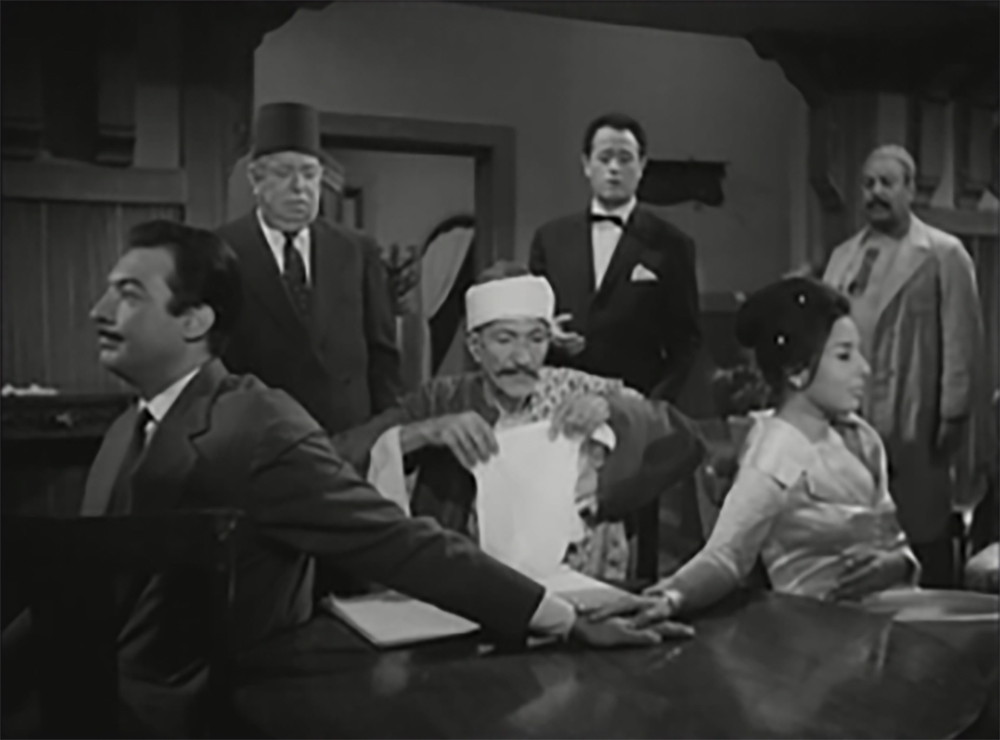
In some respects, Arabic films of The Taming of the Shrew comment on the growing feminist movement that has been active in Egypt since the early twentieth century (Badran and Cooke; Helmy 179). But Amira is not only tamed, she is humiliated, ridiculed, and deceived by her grandfather—the only dominant patriarchal figure in her life. Amira’s only saving grace, it seems, is the actor who played her, for unlike Mary Pickford or Elizabeth Taylor (Brody 23-24) whose screen presence did not seem to match Petruchio’s (Douglas Fairbanks and Richard Burton, respectively), Lubna ‘Abdel ‘Aziz remains the star of the film until the end; she is un-intimidated by Rushdi Abazah’s on-screen persona.
By casting the 1960s heartthrob Rushdi Abazah in the role of Petruchio and by calling him Hasan, of which the literal translation is “handsome,” the film seems to emphasize aspects of the socio-political changes and the shifting social order of 1960s Egypt. Ah Min Hawwa implies that Amira with her “high-nosed” social class is no longer acceptable to the post-revolutionary “socialist” Egyptian culture led by Gamal Abdel Nasser since 1952. The opulence of the country estate, Amira’s Cadillac, and the lavish feast for her birthday all signify Egypt’s wealthy elite. Hasan, on the other hand, explains that he is a commoner, “an alley-cat” who does not “deserve a princess,” but the actor’s surname prompts a different reading. Abazah is one of the most powerful and influential families in Egypt; the dynastic family name is not only steeped in the country’s history but it is also among the elitist families of Egyptian society. Therefore, the film is arguably sending a message that the most powerful families in Egypt are embracing post-revolution’s socialist ethics to which Shakespeare’s Shrew (being a foreign female protagonist) must adhere before being accepted into the new social order. Therefore, Ah Min Hawwa depicts a clash of civilizations where Shakespeare’s comedy must be cut, tailored, and re-sewn to “fit” an Arab-Islamic framework.
Placing ‘Abdel Wahab’s film in the wider field of Arabic Shakespeare, we should bear in mind that it was produced in the golden age of Egyptian cinema. A period when, for the first and only time in the history of Islam, the (Mediterranean) East and Western material cultures came closest to resembling one another. Ah Min Hawwa was released ten years after Nasser’s Revolution and five years before the humiliating loss of the Six Day-War (1967) against Israel; a watershed moment not only to Arabic Shakespeare but to all Arabic drama (Shetawi, “The Arab-West Conflict”). Furthermore, Ah Min Hawwa precedes the Islamic Revolution (Iran 1979), which sent shockwaves across Muslim societies as it widened the floodgates between secular and traditional Islam. Even geographical boundaries seemed more defined before the publication of Edward Said’s 1978 Orientalism (Armbrust 1-6). Consequently, the Egyptian socio-political landscape has changed tremendously since the release of ‘Abdel Wahab’s film. Even during the 1960s pro-Western sentiments were fast disappearing in Egypt. Anwar al Sadat’s “open door policy” in the early 1970s did little to calm anxieties about the Western way of life, which, for some, entailed unacceptable gender equalities. These factors and more might have contributed to the critical neglect of Shakespearean derivatives like Ah Min Hawwa. However, if we consider that Mamduh ‘Adwan “awakened” Hamlet in Arabic literature with his Hamlit Yastayqiz Muta’khkhiran (Hamlet Wakes Up Late) in the 1970s, then surely Muhammad Abu Yusuf did inventively tame Shakespeare’s Shrew by making it “fit” 1960s Arab-Islamic Egyptian culture.
Notes
1 I am indebted to Walter Armbrust for providing me with a copy of Ah Min Hawwa, without which this article would not have been possible. I am grateful to the editors of Literature/Film Quarterly for their continuing support and interest in my work. I am also grateful to Jacqueline Rawes and Victoria Elizabeth Straker for their invaluable feedback.
2 This figure is by no means exhaustive. For further details on Egyptian filmed Shakespeares, see Khoury (2010).
3 I have not consulted Istakoza for this article.
4 In the absence of a screenplay, I have tried to reproduce the sequence of events.
5 The Egyptian Revolution took place on 23 July 1952 when “a group of young military officers carried out a coup d’etat and seized control of the government. It was more than a brief military intervention; it was the replacement of one regime by another. Two of the officers involved in the coup, [Gamal ‘Abdel] Nasser and [Anwar al-] Sadat, were to govern Egypt for the next twenty-nine years” (Cleveland 303).
6 Unlike scholarly translations of Shakespeare that tend to be written in standard Arabic (fusha), Ah Min Hawwa uses Egyptian vernacular (‘ammiyya). To my knowledge and with the exception of some speeches in Kamal Salim’s Shuhada’ al-Gharam (Martyrs of Love, 1944), there has not been a Shakespeare feature produced in fusha. Some fusha theatre productions, however, have been recorded and broadcast.
7 Sayyid is an honorary title given to male descendants of the Prophet Muhammad.
8 The Merchant of Venice is probably the most adapted of Shakespeare’s comedies, but its Arabic reproductions usually have political significance, especially the treatment of Shylock the Jew. For political readings of the play see Mark Bayer; and Mahmoud F. al-Shetawi, “The Merchant of Venice in Arabic.”
9 The Taming of the Shrew was the first of Shakespeare’s plays to be translated into Farsi around 1900; over fifty years before Masoud Farzad’s 1957 translation of Hamlet (Horri 72).
10 For further information on the Caracalla dance-company see Khoury (2008).
11 John Fletcher’s The Woman’s Prize, or the Tamer Tamed (1611).
12 John Lacy’s Sauny the Scott (1667).
13 George Bernard Shaw and Michael Billington quoted by Ann Thompson (25).
14 As a side note, two recent books about Shakespeare on film did not include
commentary about the Shrew (Burnett; Burnett and Wray).
15 The Shrew is more acceptable to critics when it is a farce (Thompson 26).
16 Ah Min Hawwa is the only one of the four films that does not have star vocalists. However, in my opinion, ‘Ali lsma'il’s musical score surpasses any of the other films’ expression of both diegetic and non-diegetic sound.
17 The same first name is used in both films; no surname is given, but he is referred to as bey, a title equivalent to an esquire.
18 “Ma bi khalifush.”
19 All references to The Taming of the Shrew are taken from the RSC’s Complete Works, 2007.
20 There is a moment from The Merchant of Venice in this film; Sawsan’s father leaves a pre-recorded tape to be played after his death in which he outlines the qualities of his daughter’s future husband.
21 Meaning “pigheaded” but Amira refers to Hasan as someone with “the mentality of a bull.”
22 Apart from the shrew being a furry mammal, Shakespeare uses several references to animals including Petruchio who promises to tame Katherine "this wild-cat" (I.ii.183) and he calls her “My horse, my ox, my ass” (IIl.ii.220-22).
23 Sabah also drives a convertible in al-Mutamarrida.
24 Title, from the Ottoman period, is given exclusively to men of a certain rank; equivalent to a Duke.
25 The term she uses is akhi, the literal translation of which is ‘‘brother.”
26 Amira’s ride on a hay cart is a cinematic enactment of Gremio’s words “To cart her.” (I.i.55, my italics)
27 The literal translation is gentleman or sir.
28 Amira later asks suitor number nine: “Is it nature’s law to take a woman, marry her in order to get rid of your complexities and make up for your inadequacies?”
29 This scene has been cut from commercial releases.
30 Jeanne Addison Roberts writes that the image of an ass “suggests (1) that women must bear burdens; (2) that women must bear children; (3) that women must bear males in the sex act; and (4) that women as representatives of passion must be ‘ridden’ by rational male ‘riders’” (164n 12).
31 They remained in use until the nineteenth century.
32 The Arabic term suggests violent abuse, "break her nose."
33 As a side note, it is rumored that according to some Islamic sects, a man and woman arc considered husband and wife by simply being alone behind closed doors. However, I have not found written evidence that backs up this claim.
34 Islamic public notary authorized to legalize marriages and divorces. Incidentally, he is the only character who speaks fusha in the film.
35 The literal translation is “penetration night”
36 For a feminist reading of Ophelia in Arabic Shakespeares, see Khoury (2009).
37 Baptista wishes his daughter married; he makes no demands for taming her.
38 This scene has been cut from commercial releases.
39 The literal translation reads Ah (i.e. sigh) from Eve, which could mean “deliver us from Eve” or “protect us from Eve.”
40 A declaration made by the character of Isma'il Yasine in Banat Hawwa.
Works Cited
‘Adwan, Mamduh. Hamlit Yastayqiz Muta’khkhiran [Hamlet Wakes Up Late]. Beirut: Dar Ibn Rushd lil-Tiba'ah wa al-Nashr, 1980.
Armbrust, Walter, ed. Mass Mediations: New Approaches to Popular Culture in the Middle East and Beyond. Berkeley: U of California Press, 2000.
Badran, Margot, and Miriam Cooke, eds. Opening the Gates: A Century of Arab Feminist Writing. Bloomington: Indiana UP, 1990.
Bate, Jonathan, and Eric Rasmussen, eds. William Shakespeare, the Complete Works. Royal Shakespeare Company. Basingstoke: Macmillan, 2007.
Bayer, Mark. “The Merchant of Venice, the Arab-Israeli Conflict, and the Perils of Shakespearean Appropriation.” Comparative Drama 41:4 (2007): 465-92.
Boose, Lynda E. “Scolding Brides and Bridling Scolds: Taming the Woman’s Unruly Member.” Shakespeare Quarterly 42:2 (Summer 1991): 179-213.
Brody, Douglas. Shakespeare in the Movies: From the Silent Era to Shakespeare in Love. New York: Oxford UP, 2000.
Burnett, Mark Thornton. Filming Shakespeare in the Global Marketplace. Basingstoke: Palgrave Macmillan, 2007.
Burnett, Mark Thornton, and Ramona Wray, eds. Screening Shakespeare in the Twenty-first Century. Edinburgh: Edinburgh UP, 2006.
Cleveland, William L. A History of the Modern Middle East. 3rd ed. Oxford: Westview, 2004.
Dolan, Frances E. “Introduction.” The Taming of the Shrew: Texts and Contexts. Ed. Frances E. Dolan. New York: Bedford/St Martin’s, 1996. 1-38.
Helmy, Ghada. “The Plight of Women in Literary Text and Filmic Adaptation.” Alif 15 (1995): 178-201.
Horri, Abbas. The Influence of Translation on Shakespeare’s Reception in Iran: Three Farsi Hamlets and Suggestions for a Fourth. PhD diss. U of Middlesex, 2003.
Jackson, Russell, ed. A Cambridge Companion to Shakespeare on Film. Cambridge: Cambridge UP, 2000.
Kanaan, Falah. Shakespeare on the Arab Page and Stage. PhD diss. Manchester U, 1998.
Khoury, Yvette K. “Egyptian Film.” The Shakespeare Encyclopedia: Life, Works, World, and Legacy. 5 vols. Greenwood (forthcoming 2010).
—. “Representation of Ophelia in Arabic adaptations of Hamlet, is she ukht el-rijal (one of the men) or a victim of their pen?” Proceedings of the Seventh International Symposium: Comparative Literature & Linguistics: Present and Future (Apr. 2007), edited by Ahmed Etman, 204-28. Cairo, 2009.
—. “Akhir Yom (The Last Day): A Localized Arabic Adaptation of Shakespeare’s Romeo and Juliet.” Theatre Research International 33:1 (Mar. 2008): 52-69.
Roberts, Jeanne Addison. “Horses and Hermaphrodites: Metamorphoses in The Taming of the Shrew.” Shakespeare Quarterly 34:2 (Summer 1983): 159-71.
Rothwell, Kenneth Sprague. A History of Shakespeare on Screen: A Century of Film and Television. 2nd ed. Cambridge: Cambridge UP, 2004.
Rutter, Carol Chillington. “Looking at Shakespeare’s Women on Film.” Jackson 241-60.
d-Saadawi, Nawal. The Hidden Face of Eve: Women in the Arab World. Ed. and trans. Sherif Hetata. London: Zed, 1980.
Shakespeare, William. “The Taming of the Shrew.” Bate and Rasmussen 526-84.
al-Shetawi, Mahmoud F. “The Merchant of Venice in Arabic.” Journal of Intercultural Studies 15 (1994): 15-25.
—. “The Arab-West Conflict as Represented in Arabic Drama.” World Literature Today 61:1 (1987): 46-49.
Thompson, Ann. “Introduction.” The Taming of the Shrew, 2nd ed. Cambridge: Cambridge UP, 2003. 1-49.
Filmography
Ah Min Hawwa [Beware of Eve]. Dir. Fatin ‘Abdel Wahab. Perf. Lubna ‘Abdel al-'Aziz, Rushdi Abazah, Husayn Riyad, Madiha Salim, and ‘Abdel Mun'im Ibrahim. 1962.
Banat Hawwa [Daughters of Eve]. Dir. Niyazi Mustafa. Perf. Madiha Yusri and Muhammad Fawzi, Shadya and Isma'il Yasine. 1954.
Deliver us from Eva. Dir. Gary Hardwick. Perf. Gabrielle Union and LL Cool J. 2003.
Istakoza. Dir. Inas Dighidi. Perf. Raghda and Ahmad Zaki. 1996.
al-Mutamarrida [The Unruly Female]. Dir. Muhammad Dhu al-Faqar. Perf. Sabah and Ahmad Hafez Mazhar. 1963.
Shuhada’ al-Gharam [The Martyrs of Love]. Dir. Kamal Salim. Perf. Layla Murad and Ibrahim Hammuda. 1944.
The Taming of the Shrew (BBC’s Shakespeare Retold). Dir. David Richards. Perf. Shirley Henderson and Rufus Sewell, 2005.
The Taming of the Shrew. Dir. Franco Zeffirelli. Perf. Elizabeth Taylor and Richard Burton. 1967.
The Taming of the Shrew. Dir. Sam Taylor. Perf. Mary Pickford and Douglas Fairbanks. 1929.
Ten Things I Hat About You. Dir. Gil Junger. Perf. Julia Stiles and Heath Ledger. 1999.
McLintock. Dir. Andrew V. McLaglen. Perf. Maureen O’Hara and John Wayne. 1963.
al-Zawjat al-Sabia [The Seventh Wife]. Dir. Ibrahim ‘Amarah. Perf. Mary Kwayni and Muhammad Fawzi, Shadya and Isma'il Yasine. 1950.